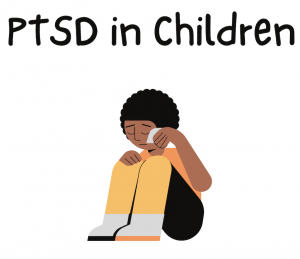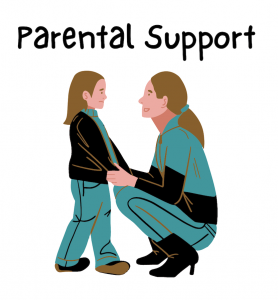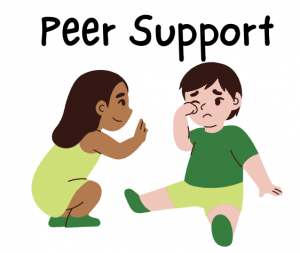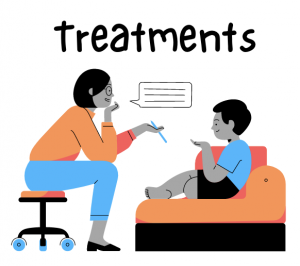24 PTSD
Kori Carter
Introduction
In post-traumatic stress disorder (PTSD), changes in the brain occur due to a traumatic event. A traumatic event can be a threatened death, serious injury, abuse, or injury and death of another (Muscari, 2012). A person can either directly experience, witness, or learn about the traumatic event from a third party, such as another person or the news. This definition has been widely used; however, it is not all-encompassing because PTSD can look different in everyone. Differences are especially seen between children and adults. Traumatic events often seen in children include physical or sexual abuse, disasters, the death of a loved one, and neglect (Muscari, 2012).

Impact of PTSD on children
PTSD can lead to mental and physical problems such as anxiety disorders, depression, increased blood pressure, and increased stress (Hales & Zatzick, 1997). A person can experience feelings of fear, anxiety, sadness, and anger. PTSD can also change sleeping patterns and eating habits (Muscari, 2012). Children can also re-experience traumatic events, such as constant thoughts about the event or having nightmares. They can become avoidant, tense, and show signs of grief and hyperarousal (Muscari, 2012). These emotions make it hard to do daily tasks, which can become extremely difficult for a child to navigate.
When a child is exposed to trauma, it can cause stress reactions that vary by age and, in some cases, by gender. A young child can demonstrate aggression, destructiveness, and repetitive play, through drawings and reenactments, about the traumatic event (Dyregrov & Yule, 2005). Preschool-aged children tend to mimic parental reactions. Children over the age of eight display reactions similar to those of an adult because they tend to understand the traumatic event better and reflect upon it (Dyregrov and Yule, 2005). Short-term reactions are trauma reminders and secondary stressors. This can include changes to family and community circumstances, ecology of the child, and other factors such as genetics and development competencies. Ecology can be parental, school, or peer factors (Meiser-Stedman, 2002).
Childhood PTSD affects the development of the central nervous system (CNS) and the neuroendocrine system (Dyregrov & Yule, 2005). These systems affect the child’s “fight or flight” response and communication. Stress reactions that come from a traumatic event can inhibit the CNS and neuroendocrine system (Dyregrov & Yule, 2005). It can lead to a child refraining from discussing the event, especially with parents when they know that it can and will upset them. This can affect a child’s sense of security, causing home-life to become worse for the child and the parent (Muscari, 2012).
Parental Support
Parental support is important for a child with PTSD. Parents and caregivers are the ones who can provide a sense of security and comfort for a child (Thabet et al., 2009). Adults tend to underestimate the severity of a child’s stress reaction from a traumatic event, and PTSD often goes unrecognized (Dyregrov & Yule, 2005).

Parents need to recognize and acknowledge signs and symptoms to help their child heal. Luckily, there are steps, methods, treatments, and protective mechanisms a parent can take in order to find what works best for their child and family.
Supportive and caring parent and child relationships positively impact a child’s emotional well-being (Thabet et al., 2009). A parent maintaining a positive and supportive role can give the child hope that it gets better in the future (Morley & Kohrt, 2013). A child will also try and forget the traumatic event through dissociation as a coping mechanism. It is important that the parent prevents forgetting about the event so that the child can be equipped with the right tools to understand their emotions. The parent can do this by creating dialogue and establishing communication. Next, a parent should help the child interpret the traumatic experience and correct any misconceptions. Afterward, a parent should manage and regulate a child’s emotions and provide positive coping strategies (Dyregrov & Yule, 2005). Some coping strategies include distractions, mindfulness, expressive writing, and social support.
Peer/Community Support

Peer support is just as important as parental support when a child is suffering from PTSD. The parent cannot fill in all of the gaps in the social support aspect that a child needs. When a child is young, their influences tend to shift from idolizing their parents to following examples set by their peers (Morley & Kohrt, 2013). As a child gets older, peer relationships make up the majority of social support. Peer relationships are important because social support is one of the critical predictors of PTSD (Morley & Kohrt, 2013). Social support comes from the child’s community. Community support positively impacts a child’s well-being and can give them a sense of protection, belonging, and hope (Morley & Kohrt, 2013). A child can socially isolate themselves when going through psychological distress as a result of PTSD, so it is important for the parents, peers, and community aid the child in their recovery. After a child goes through a traumatic event, they will eventually get back to their normal activities and schedules. The reintegration of a child can determine the long-lasting effects of PTSD. When a child does not have peer and community support, it can lead to increased functional impairment (Morley & Kohrt, 2013).
Treatments
Treatments that have been successful are trauma-focused cognitive behavioral therapy (TF-CBT) and parent-child interaction therapy (PCIT). TF-CBT is a well-established psychotherapy that focuses on children.

Trauma-Focused Cognitive Behavior Therapy (TF-CBT)
In TF-CBT, the child and parent complete an assessment to measure their symptoms of PTSD to tailor a treatment specific to them. The overall functioning of the parent is assessed since the traumatic experience directly or indirectly affected them as well (Cohen et al, 2012). In the beginning, the child and parent have separate sessions but join together in later sessions as they progress. Unfortunately, TF-CBT has limited availability in areas due to very few trained therapists. If you want to learn more, go to this link.
Parent-Child Interaction Therapy (PCIT)
PCIT is a well-respected and proven treatment where the therapist teaches the parent or caregiver how to positively interact with the child (Putnam, 2006). It is encouraged that the parent is a part of the child’s activities to set limits and create boundaries for a healthy environment. It can also greatly improve child and parent attachments (Putnam, 2006). Other protective mechanisms include social support networks and developing coping strategies to help navigate through feelings and stress of both the child and the parent or caregiver (Thabet et al., 2009). For more information about PCIT and to find a provider, please click this link.
Resources
Not every child reacts to PTSD the same, and every family deals with the aftermath of a traumatic event differently. Finding the proper help can be detrimental to the child’s recovery because it is beneficial to the child’s and the family’s future. Here is a list of resources that can help:
- The National Child Traumatic Stress Network (NCTSN)
- NCTSN provides parents with a list of resources that can cater to different aspects of PTSD, such as the integration process or a child dissociating. Here is a fact sheet about what parents should know about PTSD and dissociation.
- Center for Child Trauma Assessment, Services and Interventions
- The Center for Child Trauma Assessment, Services, and Interventions provides detailed resources specifically for parents and caregivers who believe their child is experiencing trauma or PTSD. It gives an in-depth explanation about common behaviors, how to talk with your child about their experiences, and the next steps in finding them help.
- Child Welfare Information Gateway
- Child Welfare Information Gateway is a directory page that provides a list of many resources that can help a parent understand PTSD and what to do next. It also shares resources for parents or caregivers of adopted children, trauma-informed caring training, and resources on different traumas a child may experience.
Key Takeaways
- PTSD can be very difficult for a family to maneuver.
- Children tend to have a difficult time expressing their feelings and navigating through their emotions (Putnam, 2006). That is why peer and community support is important in helping that child with their emotions and creating a foundation.
- It is important for caregivers to provide children with support and care after a traumatic event happens.
- TF-CBT and PCIT are two treatment options that can greatly impact the child’s recovery and interactions with their family. TF-CBT focuses heavily on the progress of the child separate from the parent. PCIT focuses more on how the parent or caregiver can help the child.
- PTSD and treatment options do not look the same for everyone, but as long as the persons involved are actively trying and working towards a common goal, it will positively affect the child.
References
Cohen, J., Mannarino, A., & Deblinger, E. (2012). Trauma-focused CBT for children and adolescents: Treatment applications. Guilford Press.
Hales, R. & Zatzick, D. (1997). What is PTSD? The American Journal of Psychiatry, 154(2), 143–145. https://doi.org/10.1176/ajp.154.2.143
Meiser-Stedman, R. (2002). Towards a cognitive–behavioral model of PTSD in children and adolescents. Clinical Child and Family Psychology Review, 5(4), 217–232. https://doi.org/10.1023/A:1020982122107
Morina, N., Koerssen, R., & Pollet, T. (2016). Interventions for children and adolescents with posttraumatic stress disorder: A meta-analysis of comparative outcome studies. Clinical Psychology Review, 47, 41–54. https://doi.org/10.1016/j.cpr.2016.05.006
Morley, C. & Kohrt, B. (2013). Impact of peer support on PTSD, hope, and functional impairment: a mixed-methods study of child soldiers in nepal. Journal of Aggression, Maltreatment & Trauma, 22:7, 714-734. https://doi.org/10.1080/10926771.2013.813882
Muscari, M. (2012). What nurses know…PTSD. Springer Publishing Company.
Putnam, F. (2006). The impact of trauma on child development. Juvenile & Family Court Journal, 57(1), 1–11. https://doi.org/10.1111/j.1755-6988.2006.tb00110.x
Thabet, A., Ibraheem, A., Shivram, R., Winter, E., & Vostanis, P. (2009). Parenting support and PTSD in children of a war zone. International Journal of Social Psychiatry, 55(3), 226–237. https://doi.org/10.1177/0020764008096100
An abnormal state of anxiety that derives from thinking about or experiencing a traumatic event.
repeated behaviors, like rocking back and forth and pacing, that rely on sameness and routine
the branch of biology dealing with the relations and interactions between people and their environment, including other people.
the part of the nervous system comprising the brain and spinal cord.
of or relating to the interactions between the nervous and endocrine systems, especially in relation to hormones.
mental or emotional feelings or effects, as opposed to the physical aspect
an evidence-based treatment approach shown to help children, adolescents, and their parents (or other caregivers) overcome trauma-related difficulties, including child maltreatment
an evidence-based behavior parent training treatment for young children with emotional and behavioral disorders that places emphasis on improving the quality of the parent-child relationship and changing parent-child interaction patterns
treatment of mental or emotional disorder or of related bodily ills by psychological (mental-focused) means

